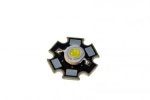I'm troubled with trying to figure out how I'm going to power a 2.8W LED that requires a max of 3.6V and 350mA. I have on my breadboard a small relay which I figure I would use to switch the LED. I have been trying to figure out a voltage divider but I'm not getting anywhere and I really don't have a clue if that would be my solution.
Jarubell
Jarubell

